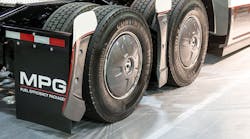Editor’s note: This is the second part of an article looking at how fleets are achieving higher MPG on U.S. roads. Read Part 1.
Many of the technologies and aerodynamic that may have first been used during the “SuperTruck” program or included on a vehicle during Run on Less are beginning to turn up on new truck models.
Freightliner’s updated model year 2020 Cascadia is 5% more fuel efficient than the previous version of the truck. When adding available aerodynamic options and upgrades, it is a whopping 35% more fuel efficient than the first-generation Cascadia, launched in 2007.
Freightliner’s top-of-the-line AeroX package includes features such as an optimized low ground clearance bumper that reduces ground clearance to just 4 inches.
Elsewhere, Peterbilt Motors’ 579 Epiq optimizes the engine, transmission and aerodynamics.
Epiq’s technologies work in tandem with Paccar’s MX-13 engine, automated transmission and rear axle. It can provide a fuel economy gain of up to 8% compared with the 579 tractor without Epiq.
Kenworth Truck Co., also part of Paccar, has a similar powertrain fuel economy package for the T680 tractor.
It includes predictive cruise control and software allowing for lower engine RPMs at cruising speeds.
Mack’s flagship, the Anthem, offers a HE+ efficiency package that combines the 13-liter MP8HE engine with Mack’s energy recovery technology. That system captures energy from the engine’s exhaust that would otherwise be wasted, and converts it to mechanical energy fed back to the engine crankshaft as additional torque. When complimented with other aerodynamic and efficiency enhancements the HE+ package can result in up to a 9.5% gain in fuel economy.
Volvo Trucks’ Xceed package for its model year 2020 VNL 760/860 long haul tractors offer advanced lightweighting options, along with powertrain optimization and aerodynamic enhancements to deliver a fuel efficiency improvement of up to 11%.
The company’s Payload Plus package —included in Xceed and available on its own — shaves up to 540 lbs. from VNR regional haul models and more than 335 lbs. from VNL trucks.
Another efficiency option for fleets is the MPG Package from International Truck for the LT series. It includes chassis skirts, roof fairing, cab extenders, and an optional bumper valance. An enhanced MPG Package adds predictive cruise control and the FlowBelow Tractor AeroKit system.
Navistar also said a third-party company found the LT series equipped with its 12.4 liter A26 engine proved to be the most fuel efficient truck and engine combination of the models tested.
Meanwhile, independent engine maker Cummins Inc. offers two unique series for its X15 engines. The company said the X15 efficiency series has the highest compression ratio in the industry, for unmatched fuel efficiency and responsiveness, delivering up to 1850 lb.-ft. of torque starting at 1000 rpm.
Cummins said drivers using a 2010 truck can obtain up to 20% higher fuel economy with the X15. That number could go even higher when combined with the SmartAdvantage powertrain system from Cummins and Eaton.
Cruise control
During the Truckload Carriers Association’s annual conference earlier this year, RaNae Isaak, powertrain leader for Cummins, stressed that greater use of cruise control can make a big difference in fuel efficiency.
Cruise control helps keep the RPMs in the “sweet spot,” though often times truckers are failing to use the feature even 25% of the time.
During the same panel discussion, Nussbaum said he was convinced that slowing down a few miles per hour, such as through the use of cruise control, “creates less wear and tear on both the truck and the driver, all while saving money.”
Mike Roeth, executive director of the North American Council on Fuel Efficiency (NACFE), agreed with these comments, but also stressed that it needs to make financial sense.
“Go faster when you need to for profitability,” Roeth said. “Go slow when you don’t.”
Isaak also spoke about several factors that Cummins targets for improvements, starting with idling.
“From an engine maker’s perspective, it is impossible to completely eliminate idle time, so it’s about minimizing fuel usage during that time,” she said.
Additionally, a focus on engine downspeeding remains a constant in order to move “RPMs down so the powertrain doesn’t have to do as much work,” Issak said.
There are also secondary gains that fleets don’t always think about.
For example, as oil drain intervals expand, it could mean better fuel economy through fewer out-of-route stops for oil changes and related maintenance.
Randy Morgan, chief operating officer of Comdata, said truckers should not necessarily be chasing the absolute lowest price of diesel.
He said it is not uncommon for Comdata to recommend having a trucker fill up at a station where the price is slightly higher because it has multiple other business and personal services available.
“We pride ourselves in educating drivers and fleets how to take miles out,” Morgan said.
He added that Comdata offers drivers the ability to have their vehicles weighed by Cat Scales without having to get out of the truck.
That is another example of needing to stop and start the truck fewer times. In the end, that equals better fuel economy, Morgan said.
A final thought
Even with the endless focus on fuel economy, Lloyd Palum, chief technology officer of Vnomics, said it is important to focus on more than just a bottom-line number.
What a fleet should actually focus on is determining “are you being efficient under the context you are currently running.”
For example, low-mileage trips are likely to have a lower mpg, but that does not mean the driver or equipment is not performing properly.
Similarly, unexpected congestion or other incident creating a delay will lower the fuel economy of any particular freight shipment.
Editor’s note: This is the second part of a two-part look at how fleets are achieving higher MPG on U.S. roads. Read Part 1.



